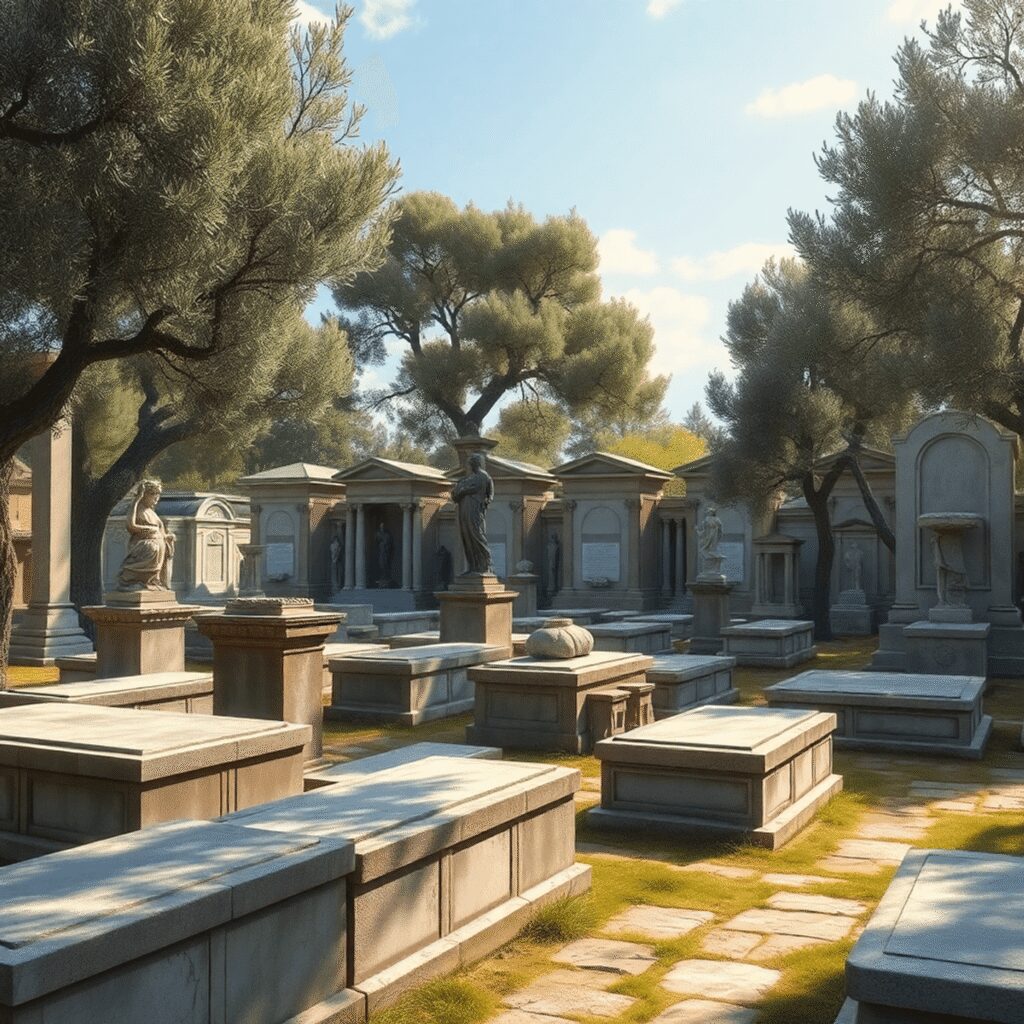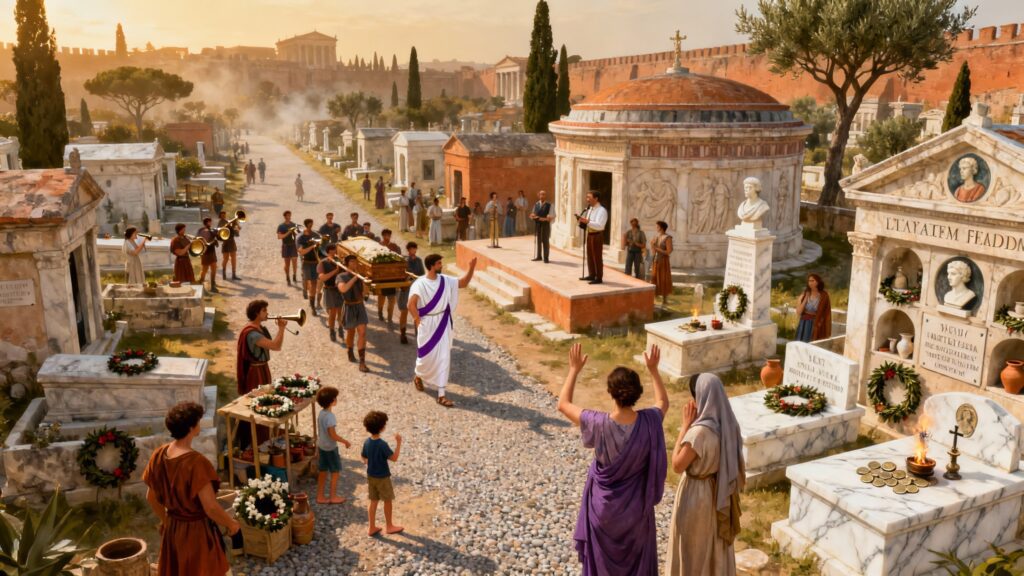Roman funerary customs were complex rituals deeply embedded in the social and cultural fabric of ancient Rome. These practices marked the transition from life to death, not only honoring the deceased but also reaffirming community bonds and shared beliefs about the afterlife. Funerals involved family members and friends accompanying the dead, ensuring a passage that was both physical and symbolic.
Roman cemeteries functioned as more than mere burial sites. They were vibrant community hubs where people gathered for mourning rituals, remembrance, and social interaction. These spaces provided a setting for expressing collective identity and maintaining social ties across generations.
This article explores the multifaceted role of Roman cemeteries by focusing on three key aspects:
- Mourning: The gendered roles and emotional expressions surrounding death.
- Memory: How funerary practices preserved the legacy of the deceased within society.
- Social rituals: The ways cemeteries served as centers for communal activities and reinforced social hierarchies.
Understanding Roman Cemeteries as Community Hubs: Mourning, Memory, and Social Rituals opens a window into how ancient Romans navigated death as a shared cultural experience rather than an isolated event.
Such funerary customs were often accompanied by artistic expressions that reflected the social, political, and cultural dynamics of the time. For instance, Masterpieces of Roman Art serve as a testament to this artistic evolution. Additionally, the evolution of Roman sculpture showcases how these sculptures captured realism and power, often serving as instruments for political propaganda and religious devotion.
Moreover, these customs were influenced by various factors including military power. The Roman military, known for its discipline and strategy, played a significant role in shaping the empire’s vast reach.
Lastly, the belief systems surrounding death were intertwined with the Roman Pantheon, a diverse collection of gods and goddesses worshipped in ancient Rome that reflected its values, beliefs, and customs.
The Many Roles of Roman Cemeteries
Roman burial sites were more than just places to bury the dead. They played a crucial role in ancient Roman society as places for communal mourning, social rituals, and preserving memories. Cemeteries served multiple purposes where the living actively engaged with death, shaping and expressing their collective identities.
Key Functions of Roman Cemeteries
Here are some key roles that Roman cemeteries fulfilled:
1. Community Gathering Spaces
Funeral sites served as both physical and symbolic locations for people to come together. Families, neighbors, and even larger social networks would meet at these places not only to pay respects to the deceased but also to strengthen social ties among the living. Public funerals often included processions and ceremonies that attracted spectators, creating opportunities for community interaction.
2. Social Expression
Tombs and monuments were used to showcase one’s status, accomplishments, and family background. Through inscriptions, sculptures, and intricate designs, individuals communicated their position within society. These expressions went beyond personal remembrance; they reinforced local hierarchies and promoted social unity by visibly connecting the deceased to their community.
3. Blending Death Rituals with Public Life
Death was intertwined with public life through ritualistic performances during funerals. Mourning customs, purification rites, and commemorative events linked private sorrow with civic identity. By participating in these rituals, Romans collectively navigated the transition between life and death while reaffirming shared cultural values.
The various functions of these spaces highlight how Roman cemeteries were vibrant environments where memory preservation occurred on both personal and societal levels. They acted as lively hubs of interaction rather than secluded areas of grief or silence. This complex role significantly influenced how Romans perceived community and continuity in the face of inevitable mortality.
Additionally, the study of these burial sites offers significant insights into how memory is preserved over time, revealing much about societal values, beliefs, and cultural practices in ancient Rome.

Rituals of Mourning in Ancient Rome
Roman mourning practices were deeply influenced by gender roles in funerals, dividing responsibilities between men and women with clear social expectations.
Women’s Role in Funerary Rites
Women played a crucial role in expressing grief during funerals. They performed lamentation rituals—vocal, emotional displays of sorrow that included wailing, singing dirges, and sometimes ritual tearing of hair or clothing. These acts were not just personal expressions of loss but served a communal purpose: they publicly acknowledged the death and helped preserve the memory of the deceased within the community. Women’s lamentations also acted as a bridge between the living and the dead, reinforcing cultural beliefs about honoring ancestors.
Men’s Duties in Funeral Organization
Men had specific responsibilities related to funeral organization and public representation. Their tasks included overseeing practical arrangements such as carrying the body, managing the funeral procession, and making formal speeches (laudationes) that celebrated the virtues and achievements of the departed. These speeches reinforced family honor and social status, crucial elements in Roman society.
Notable Instances of Male Participation
While it was less common for men to engage directly in mourning behavior, there were notable exceptions. Elite males sometimes displayed public grief during funerals to demonstrate filial piety or political loyalty. For instance:
- Prominent men might weep openly or deliver eulogies that combined personal loss with civic values.
- Participation by male mourners at elite funerals elevated the social significance of mourning rituals beyond private grief into a form of public spectacle.
This gendered division framed mourning as both a personal and social act, where women embodied emotional remembrance while men enacted communal recognition. Understanding these roles clarifies how Roman mourning practices integrated individual sorrow with societal expectations, reinforcing identity through ritualized expressions of loss.

Connection to Broader Roman Culture
These mourning practices were often intertwined with broader rituals and sacrifices, highlighting how Romans connected with their gods through various ceremonies. This connection to the divine was an integral part of their culture, influencing not just funerary rites but all aspects of life.
In addition to these rituals, the legal framework governing such practices was significantly shaped by the enduring legacy of Roman law, which continues to influence modern legal systems worldwide.
However, it’s important to note that these traditions and laws existed within a context marked by political instability and weak leadership, factors that ultimately contributed to the decline of the Western Roman Empire. The interplay between these internal strife and ineffective governance demonstrates how deeply interconnected various facets of Roman society were.
Lastly, even in mourning, elements such as coins were used not just as currency but also as tools for propaganda, conveying authority and legitimacy which further underscores the complexity and depth of Roman cultural practices.

Purification Rites and Symbolic Boundaries in Roman Funerary Practices
Roman funerary customs included carefully structured purification rites performed after burial ceremonies. These rituals were essential for marking the transition between life and death boundaries, ensuring that mourners could safely re-enter daily life without spiritual contamination.
Typical Acts of Purification
Typical purification acts involved:
- Ritual cleansing of the family and participants using water or incense smoke.
- Sacrifices or offerings to appease the spirits of the dead.
- Specific prayers and chants invoking protection from malevolent forces.
- The symbolic removal of mourning attire and restoration of social roles.
The purpose extended beyond physical cleanliness. These rites served as a formal declaration that the deceased had moved into the realm of the dead, separating them from the living. This separation was crucial in Roman belief systems, creating a clear spiritual boundary that preserved social order and cosmic balance.
The purification process reinforced cultural understandings of death as a passage rather than an end. It allowed mourners to acknowledge loss while safeguarding themselves from lingering ritual impurity. Only after completing these rites could individuals resume participation in public and religious life without risk.
By performing these ceremonies, communities collectively affirmed their relationship with both ancestors and gods. Purification rites acted as a bridge connecting Roman cemeteries as community hubs: mourning, memory, and social rituals. They shaped how Romans navigated grief, memory preservation, and reintegration into society following death-related events.
Moreover, these funerary practices were intertwined with various aspects of trade and economy in Ancient Rome. Understanding these economic practices not only sheds light on the daily life of Romans but also reveals how they influenced long-term stability within one of history’s most powerful civilizations.

Memory Preservation Through Funerary Practices
The Romans saw death as more than just the end of life; it was also a way to pass on their culture. This process, known as cultural death, involved the deceased moving from being a part of everyday life to becoming a lasting memory within the community. The living had an important role in keeping this connection alive, making sure that remembering the dead was not just something done privately but also publicly and continuously.
Key elements of memory preservation included:
- Commemorative rituals: The Romans held annual offerings (sacrificia) at the tomb as a way to strengthen the bond between the living and the dead.
- Recitation of laudes funebres: During funerals, they would praise the deceased by highlighting their virtues and achievements, reinforcing their social identity even after death.
- Tomb inscriptions and epitaphs: These served as permanent markers conveying lineage, status, and personal stories, making memory tangible for future generations.
- Display of funerary monuments: Families would place visible monuments in public spaces to assert their social standing while inviting recognition from the community.
These practices shaped how Romans understood death as both an ending and a transformation. By embedding the deceased within collective memory through ritual acts, they ensured that death created continuity rather than disruption within society. The cemetery became a living archive where memory was actively nurtured, connecting past and present in a shared cultural space.
The influence of these funerary practices on Western civilization is profound. The Romans, with their intricate social structures, cultural practices, and innovative ideas, laid the groundwork for many aspects of modern life. From their legal systems to their architectural marvels, the legacy of Rome is woven into the very fabric of contemporary society.
The Social Functions of Roman Funerary Spaces as Community Hubs
Roman cemeteries were more than just places for the dead to rest. They were vibrant expressions of social identity, where the living could openly showcase their family status and social hierarchies. These spaces reflected the structure of Roman society, mirroring distinctions between classes and reinforcing relationships among community members.
1. Social Hierarchies Displayed Through Burial Practices
The location and grandeur of tombs often corresponded to the social rank of the deceased. Elite families constructed elaborate mausolea or monumental tombs near major roads or city entrances, signaling prominence and power. Common citizens’ graves were simpler and situated farther from main thoroughfares, visibly marking social stratification even in death.
2. Funerary Monuments as Communicative Tools
Tomb inscriptions served as public records of lineage, achievements, and virtues. These epitaphs highlighted familial connections, political offices held, military honors, or acts of public service. This practice was a form of social messaging, enabling descendants to claim prestige and affirm their place within the community’s collective memory.
3. Community Bonds Reinforced Through Shared Spaces
Cemeteries provided a setting for ongoing interaction among living relatives and neighbors. Visiting tombs was an act that maintained bonds across generations, preserving a shared identity grounded in ancestry. The monuments became physical sites where kinship ties were celebrated and social networks reaffirmed.
Roman funerary spaces thus operated as active centers for expressing identity and status—tools for both remembering the dead and shaping communal relationships among the living.

Communal Mourning as a Social Ritual in Ancient Rome
Communal mourning practices were very important in the social life of Roman communities. Mourning wasn’t something done alone; it was a shared experience that included neighbors, friends, and even people you didn’t know well. This collective participation created a feeling of belonging and support during times of grief, resembling the lamenting practices observed across different cultures and epochs.
Funerals: A Time for Community Connection
Funerals offered a specific time and place where social connections went beyond just the immediate family. When people attended these events, it showed respect for the person who had died and also confirmed their role within the community. By grieving together and performing rituals, attendees strengthened relationships that linked various parts of society.
Key Aspects of Communal Mourning
Some important aspects of communal mourning in Ancient Rome were:
- Public expressions of grief: Groups, often led by professional mourners or female relatives, openly expressed their sorrow, creating a powerful display of collective sadness.
- Ceremonial gatherings: The procession to the burial site and subsequent ceremonies provided opportunities for people to come together socially and reinforce their community bonds.
- Mutual responsibilities: Taking part in funerary rituals established or reaffirmed social debts and alliances among families and groups.
Roman Cemeteries: Spaces for Memory and Emotion
Roman cemeteries served as community gathering places where memories and feelings intertwined with social structures. Mourning rituals played a vital role in maintaining unity and continuity within the larger community, shaping its identity through shared experiences of loss. This concept echoes the idea that grief and mourning are not just ends, but also a continuity of life that binds us together as a community.

Conclusion
Roman cemeteries are more than just places where people are buried. They were important community spaces where grieving, remembering, and social ceremonies came together to shape and strengthen group identities. The activities seen in these burial practices show a society that was deeply involved with the cultural changes surrounding death—signifying not just the end of physical existence but also ensuring that memories lived on within social structures.
Studying Roman burial customs provides valuable understanding of ancient Roman society:
- Grieving rituals highlighted the importance of collective involvement and defined roles for men and women, reflecting wider social patterns.
- Preserving memories through engravings and memorials connected different generations and upheld family traditions.
- Community ceremonies promoted unity by turning cemeteries into lively places for interaction instead of lonely spots for mourning.
Roman cemeteries as gathering places demonstrate how death rituals strengthened social connections while navigating the line between life and what comes after, emphasizing their lasting cultural significance.
FAQs (Frequently Asked Questions)
What roles did Roman cemeteries play beyond being burial sites?
Roman cemeteries served as multifunctional community hubs where mourning rituals, social interactions, and memory preservation took place. They acted as centers for communal gathering, social expression, and reinforced collective identity in ancient Rome.
How were mourning rituals gender-specific in ancient Roman funerals?
In Roman funerary practices, there were distinct gender roles: women primarily performed lamentation rituals and played a key role in preserving memory through mourning, while men typically handled other funeral responsibilities. However, men also participated in mourning ceremonies, especially for elite individuals.
What purification rites were involved in Roman funerary practices and what was their significance?
After burial ceremonies, purification rites were performed to symbolically cleanse mourners and establish boundaries between life and death. These rituals allowed mourners to safely return to daily life while respecting spiritual transitions and reinforced cultural understandings of death and the afterlife.
How did Roman funerary practices contribute to memory preservation within the community?
Roman funerary customs conceptualized death as both a physical and cultural transition. Through commemorative rituals and ongoing remembrance activities at cemeteries, the memory of the deceased was actively preserved within the community context, ensuring their legacy endured beyond death.
In what ways did Roman cemeteries reflect social hierarchies and reinforce social relationships?
Cemeteries in ancient Rome showcased social identity through funerary monuments and tomb inscriptions that communicated family lineage and achievements. These spaces reinforced social hierarchies and relationships among living members by publicly displaying status and heritage.
Why was communal mourning considered an important social ritual in ancient Rome?
Communal mourning fostered community bonding by encouraging joint participation beyond immediate family circles. Funerals served as occasions that strengthened social ties, reinforcing shared identities and collective support within Roman society.

